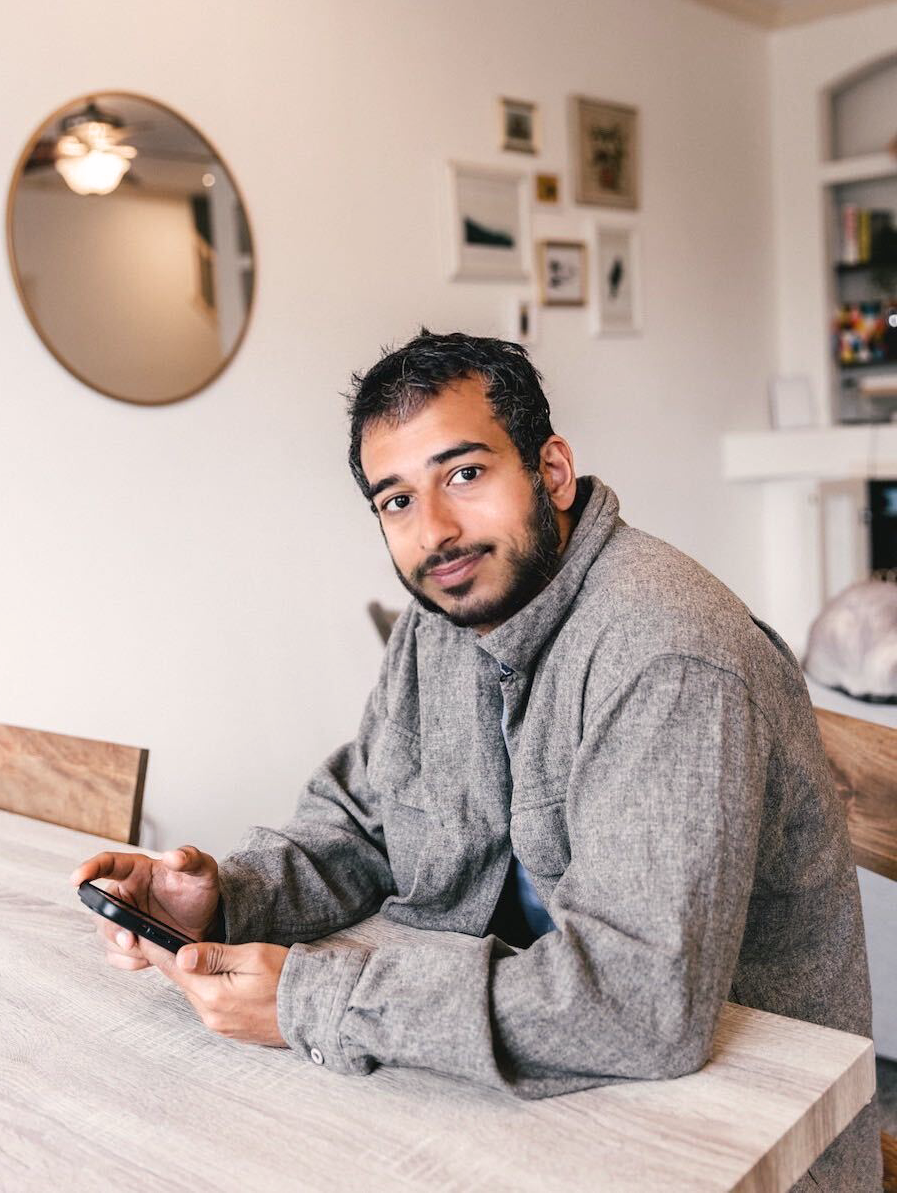Sahil Lavingia thinks you should crowdfund
Gumroad's CEO on bootstrapping and funding alternatives to VC.
Written by Shreeda Segan
Photography by Brian Simcoe
The current shift in macroeconomic conditions is something most founders still haven’t adjusted to, according to Gumroad CEO Sahil Lavingia. “A 4.5% interest rate is profoundly different from one that’s zero,” he says, dialing in from his home in Beaverton, Oregon. “It feels like the entire world should change. It’s as if gravity went from one to 1.2. All of physics on earth would be different.”
For founders, higher interest rates might mean that venture capital behaves differently. Speculators have wondered whether LPs and VCs will run to store their money in less risky, more certain-to-profit ventures, making it harder to raise money for unconventional ideas — or for unconventional founders to raise money.
Lavingia is not one to worry, either about himself or about the startups around him. Gumroad, a marketplace that helps creators sell products and raised $5M in a community round in 2021, has seen its fair share of troubles. Lavingia was once convinced that the startup would become a unicorn.
But, by the end of 2015, Gumroad struggled to raise enough money for a complete Series B. The company was continuing to grow linearly — but not at the exponential rate required to convince investors that Gumroad had the potential to reach a $1B+ valuation.
Lavingia made some unconventional choices then. He came to terms with a shrinking runway and laid off the entire company, aggressively cutting costs wherever possible without fully shutting down the service. He didn’t sell the company out of a sense of duty to the creators who used the platform. He ran it solely on his own.
The community round was raised in March 2021, right after the SEC passed new regulation allowing companies to raise up to $5M (up from the previous $1.07M) from crowdfunding. That made it one of the first companies to do so. Gumroad also raised an additional $1M during the time of the community round from investors Naval Ravikant and Jason Fried, founder of famously-bootstrapped Basecamp.
And it hasn’t raised since.
So when Lavingia says it's time for startups to get creative about how they're funding their businesses, he speaks from experience. "VCs should invest in things that only venture capital can fund,” he says to me, repeating words that Marc Andreessen once told him. “There’s a band of things that should be funded by venture, but it’s really a small band: things that are in software or tech, have a 10- to 15-year time horizon, and need to raise millions of dollars to really take off.”
Creativity means thinking beyond bootstrapping, the natural go-to for startups looking for alternative funding. “When you want to have an engineer or react to developments in AI, you’re going to want to have a few thousand dollars ready to spend,” he says. “As a bootstrapper, it can take years to have any real disposable income to make such bets.”
Instead, he says to steer in any direction that gets your business cashflow. “Cashflow is being rewarded in this market,” he says, “especially if you’re not trying to set on building a massive unicorn and are happy to eventually get to $1M in annual recurring revenue (ARR).” Due to rising rates, money today is worth more than money tomorrow — your money can earn even when it's idle.
In Lavingia's canon, a business should take funding that complements the certainty of its cashflow. If there’s nearly 100% certainty around predicting your cashflow — a common scenario for freelancers who sell fixed services at fixed rates — bootstrapping makes the most sense.
But as times grow uncertain and companies continue to make uncertain bets, external funding has its pros. That’s where Lavingia’s favorite type of funding steps in.
“If I were starting a new company, it's equity crowdfunding from the beginning,” he says. This is particularly fruitful, he says, for those businesses that don’t want to sacrifice the bump that comes from traditional venture capital, but also don’t want to subscribe to hyper-growth narratives. And since the amounts raised through equity crowdfunds are typically smaller than those raised through VC, founders are much more likely to get positive cashflow much sooner.
“In the past, startups would often raise one round of funding, ship a product, and go public,” he says. The money raised during this IPO would sustain the business for the long haul. But with low-interest rates, VC found its way into this sweet spot. In Lavingia’s canon of startup financing, the equity crowdfund might be able to take the place of those VCs.
Lavingia adds that equity crowdfunding is a bit closer to the IPO than traditional VC, in that it brings in a community of people who are excited about the business. Equity crowdfunding allows founders to share their profit out as dividends with investors — like how P&G or AT&T might do it.
~
Lavingia grew up in Singapore. “The only way to make money as a 13-year-old kid was PayPal,” he remembers. He taught himself web design and development in order to sell his services. Then, he stumbled upon Hacker News, TechCrunch, and the online world of startups — right at the early stages of the “tech boom.” Interest rates were low and tech products and companies from smartphones to ecommerce were beginning to take off.

Never miss another untold story.
Subscribe for stories, giveaways, event invites, & more.
Although his parents expected him to get a four-year degree and move to New York City to become a banker or lawyer, Lavingia decided to move to San Francisco in 2010. He knew it would be his first opportunity to connect with hundreds of people in-person, “people who also knew what Hacker News was,” he laughs. He joined the University of Southern California, and dropped out after a semester to join Pinterest.
He built Pinterest’s first iOS app during the day. On evenings and weekends, he freelanced for startups and went to Y Combinator’s Startup School. Gradually, the idea of selling a product to a market, at scale, grew more appealing than the thought of climbing the corporate ladder. “It just felt very meritocratic in a way,” he remembers. “It felt like no one could really stop me but me.”
Fast forward a year. Lavingia had spent a few hours designing and fine-tuning an icon for one of his freelance projects. He wanted to make the icon available to others for purchase but there were dozens of steps involved. Over the weekend, he wrote the foundational code for what would later become Gumroad. In the process, he solved his own problem.
"VCs should invest in things that only venture capital can fund."
Lavingia was convinced that Gumroad had the potential to become a unicorn. The company went on to raise $10M in seed, Series A, and additional funding between the years 2012 to 2015 from funds and investors like First Round Capital and Naval Ravikant.
So when he had to aggressively downsize his company, Lavingia was burned out. He felt like a failure. He moved from San Francisco to Provo, Utah. He took a science fiction writing class. He’d always been a fan of the arts, and thought that a change of scenery and vocation would help him recover from burnout while processing his failure to build a unicorn.
The locals he opened up to in his classes often asked Lavingia why he thought Gumroad was a failure. They pointed out that his company was improving people’s lives and continuing to grow. Although Lavinigia was interacting with an entirely different community from his old group of Bay Area techies and founders, Lavingia decided something. His relentless pursuit of unicorn status had overshadowed the initial vision and purpose of the company: helping creators make a living doing what they love.
Sustainability and profitability began to replace hypergrowth and unicorn status as Lavingia’s definitions of a successful business. The new Gumroad would cut out all meetings and deadlines. It would focus solely on shipping products that empowered creators to sell. Instead of hiring full-time employees, the company turned to hourly contractors. “A business at the end of the day is a cashflow machine,” says Lavingia. “The truest measure of a successful business is just the cashflow that it is generating.”
~
In Provo, Lavingia spent several months drawing, oil painting, and writing science fiction — pursuing any germ of creativity that could lead him away from writing software. Ironically, the experience revealed to him the exact opposite of what he'd set out to find: he was not only good at writing software, he also genuinely liked it. He couldn’t say the same about the arts, where he struggled to truly excel.
Later, when he went on to write his book The Minimalist Entrepreneur, he began to expand his idea of what made a “creator.” A creator was anyone building solutions to solve real problems, even when those solutions were pieces of software.
Lavingia cites entrepreneur Kyle Webster as a prime example. Webster sold custom brushes for Adobe Photoshop on Gumroad — a solution Webster himself had been looking for. He sold over 1,000 brushes. In 2017, Adobe acquired his business, giving all Creative Cloud customers access to his brushes. They also hired him. Webster continues to sell some of his tutorials, layouts, and shortcuts on Gumroad.
"A business at the end of the day is a cashflow machine. The truest measure of success is just the cashflow that it is generating.”
When I ask Lavingia what he is working on, he tells me that he is trying to build a GPT-4-based tool that automates as much support as possible at Gumroad. His code will piece together information from Gumroad’s help docs and previous support responses to automatically respond to customer inquiries. He hopes for it to one day save Gumroad a couple of hundred thousand dollars a year in customer support, sharing how the company gets around 6,000 tickets a month.
“I use my own book to remind myself of the strategy that actually works because it's so easy to get distracted by cool technology,” he says. “That’s fine if you want to build for fun. But to build a business, the most reliable thing is to just best solve an exact problem that you actually have and just not think about it like a business. And then maybe, it will turn into something more."
More Like This
